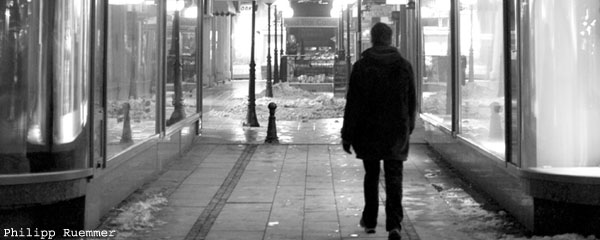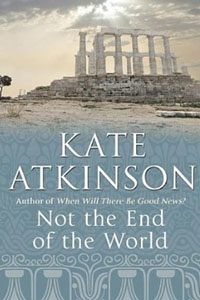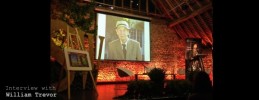
photo by Philipp Ruemmer
by Tracy Fells
Kate Atkinson’s debut novel, Behind the Scenes at the Museum, was published to critical acclaim, winning the 1995 Whitbread Book of the Year. Human Croquet and Emotionally Weird quickly followed, all populated with quirky but likeable characters. Awarded an MBE in 2011, and with her best-selling series of crime novels – featuring the private detective Jackson Brodie – televised by the BBC, Atkinson’s stature as a writer seems well established. But, like many novelists, Kate Atkinson started her literary career writing short stories. Having won a Woman’s Own short story competition in 1988, Atkinson went on to win the Ian St James award in 1993, and her collection of short stories, Not the End of the World, was published in 2002. The title is taken from the last line of the final story, ‘Pleasureland’. We all say it, yet when Trudi chirpily regurgitates the familiar old adage to her best friend Charlene – “Don’t worry, it’s not the end of the world” – sadly, we know it really is the end of Charlene and Trudi’s world.
 We are first introduced to Charlene and Trudi in the opening story of the collection, ‘Charlene and Trudi Go Shopping’. Each of the twelve stories in Not the End of the World takes something from another story – either continuing a sub-thread of another plot, or featuring a character in a minor role, or simply a passing reference. This interconnectivity of the stories mirrors life and all its peculiar coincidences. It doesn’t come as a surprise when the natural arc of the collection takes us back to Charlene and Trudi in the finale of ‘Pleasureland’. The pair take centre-stage again, obsessing about a consumer world that has gone forever, while all around them society degenerates into violence and chaos.
We are first introduced to Charlene and Trudi in the opening story of the collection, ‘Charlene and Trudi Go Shopping’. Each of the twelve stories in Not the End of the World takes something from another story – either continuing a sub-thread of another plot, or featuring a character in a minor role, or simply a passing reference. This interconnectivity of the stories mirrors life and all its peculiar coincidences. It doesn’t come as a surprise when the natural arc of the collection takes us back to Charlene and Trudi in the finale of ‘Pleasureland’. The pair take centre-stage again, obsessing about a consumer world that has gone forever, while all around them society degenerates into violence and chaos.
Many of Atkinson’s stories are a quiet comment on humanity. She writes about the boundaries between worlds in ‘Evil Dopplegängers’, where a gossamer thin veil allows dopplegängers to step across and hijack the lives of their duplicates. The rather lacklustre journalist, Fielding, suspects that someone looking just like him is having the sex life he can only dream about. Fielding’s always one step behind until he comes face-to-face with his dopplegänger – in bed with his archenemy.
Proceeding with caution, Fielding opened the door to the bedroom. Flavia, unattractively flushed with exertion, was lighting up a cigarette. She gave a little scream of horror when she caught sight of Fielding. Her partner lay next to her, equally post-coital. Every aspect of his figure was familiar. Fielding tried closing his eyes and breathing deeply for ten seconds but when he opened his eyes again, nothing had changed. ‘You’re me,’ he said weakly.
‘On the contrary,’ the other Fielding said with a superior smile, ‘you’re me.’
In ‘Temporal Anomaly’, Atkinson makes us face our own worst fear: sudden death. ‘Marianne was thinking about lemons when she died.’ This opening immediately tells us Marianne’s fate, but she lingers on as a ‘living ghost’. She can’t be seen, but can happily eat, drink and watch telly. As Marianne watches her family carry on with life without her, we see Atkinson’s real skill come through, in her ability to manipulate the reader’s emotions. First, she makes us settle back, all cosy and comfortable, with wry smiles. Then suddenly she twists the plot and makes us blink back tears. Marianne walks home after her fatal accident. Her little boy, Liam, is sleeping, so she curls up beside him:
…the bedroom door opened and Robert entered the room. Marianne couldn’t remember when she had been so pleased to see Robert, not for years certainly.… Her mouth was so dry and ashy that she could hardly speak. ‘Robert,’ she croaked. ‘I’m all right.’ Robert sat on the edge of the bed. He looked dreadful, his skin grey, his eyes bloodshot and baggy. ‘I’m all right,’ Marianne repeated. Robert shook Liam gently awake.
‘Liam,’ Robert said, his face crumpling in a way that made Marianne worry for him, ‘Liam, something very bad has happened. To Mum. A very bad thing.’
 All the stories in this collection contain an undercurrent and mischievously interweave the mundane with fantasy. Greek gods and magical shawls promising eternal life intermingle with testing teenagers and list-obsessed women. Out of the twelve stories, the one that lingered with me longest was ‘The Cat Lover’. This, like many of the stories, at first appears a rather ordinary tale: a lonely, embittered woman finds companionship with a stray cat that follows her home one stormy night. But we discover that Heidi is terrified of ending up with a dribbling old man as her life partner, and instead she finds her cat gradually developing human, and particularly male, traits.
All the stories in this collection contain an undercurrent and mischievously interweave the mundane with fantasy. Greek gods and magical shawls promising eternal life intermingle with testing teenagers and list-obsessed women. Out of the twelve stories, the one that lingered with me longest was ‘The Cat Lover’. This, like many of the stories, at first appears a rather ordinary tale: a lonely, embittered woman finds companionship with a stray cat that follows her home one stormy night. But we discover that Heidi is terrified of ending up with a dribbling old man as her life partner, and instead she finds her cat gradually developing human, and particularly male, traits.
The stray, renamed as ‘Gordon’, first skinny and malnourished, grows to the size of a tiger and takes to sharing Heidi’s bed. He lounges on the sofa, sitting upright with legs crossed – just like a man – drinking lager straight from the can. Atkinson casually drops a splash of an alternative reality into the story when she lists the victims of Gordon’s slaughter. Amongst owls and larks and flocks of starlings, Gordon has also brought home:
…a secret cache of dodos, the odd phoenix… and… the hawk-headed sun god Ra – an event which caused the world to go dark until Heidi helped him escape from the cat’s clutches.
The conclusion of this story has a delightful surprise for Heidi. It’s a true twist-in-the-tale that really made me smile.
Not the End of the World, like all Atkinson’s novels, resonates compassion and humanity. She is an intelligent writer who doesn’t bludgeon her readers with lofty concepts or convoluted narrative, instead she lightly camouflages tragedy with comedy. Many of the printed reviews for the collection describe it as ‘playful’, along with ‘fizzing’, ‘zestful’ and ‘inventive’. Like the gods who flit in and out of these stories, Atkinson is playing with humanity, but ultimately she is on the side of the mortals.

